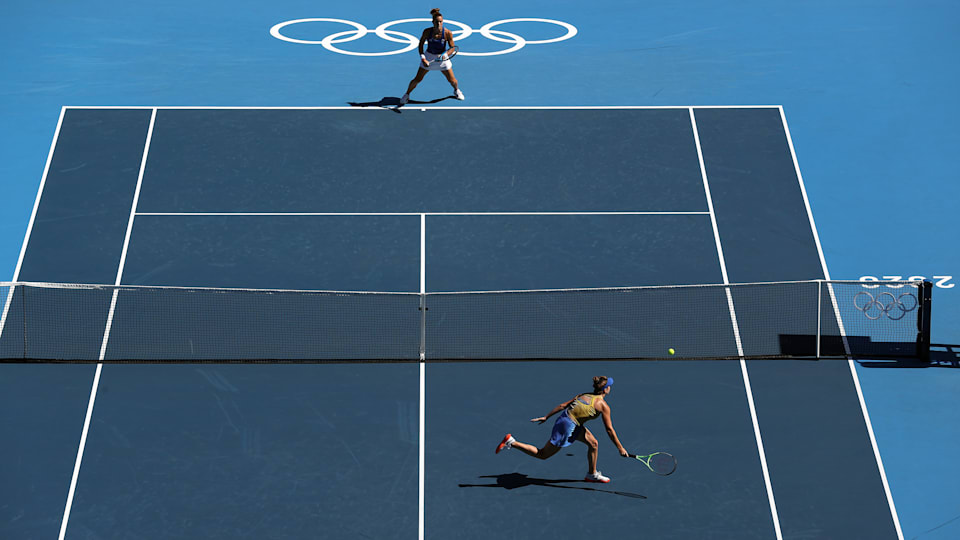Unraveling the Mystique of Tennis: A Journey Through the Courts of History
 In the world of sports, few activities possess the grace, athleticism, and intensity that define the game of tennis. From the hallowed lawns of Wimbledon to the hard courts of the US Open, tennis has captured the imagination of fans around the globe, offering a spectacle of skill, strategy, and sheer determination. In this exploration of tennis, we delve deep into its origins, evolution, iconic players, and enduring legacy that continues to inspire generations.
In the world of sports, few activities possess the grace, athleticism, and intensity that define the game of tennis. From the hallowed lawns of Wimbledon to the hard courts of the US Open, tennis has captured the imagination of fans around the globe, offering a spectacle of skill, strategy, and sheer determination. In this exploration of tennis, we delve deep into its origins, evolution, iconic players, and enduring legacy that continues to inspire generations.
Origins and Evolution
The origins of tennis can be traced back centuries, with early forms of the game believed to have been played by ancient civilizations such as the Egyptians, Greeks, and Romans. However, it was in medieval France that tennis, or "jeu de paume" (game of the palm), began to take shape as a popular sport played in courtyards and royal estates.
As the game evolved, so too did its equipment and rules. The introduction of rackets, the standardization of court dimensions, and the establishment of formalized scoring systems paved the way for modern tennis as we know it today. The 19th century saw the development of lawn tennis, with major tournaments such as Wimbledon and the US Open emerging as premier events in the tennis calendar.
The Majestic Grand Slam Tournaments At the pinnacle of professional tennis stand the Grand Slam tournaments: the Australian Open, the French Open, Wimbledon, and the US Open. These prestigious events, held annually on different surfaces and continents, represent the ultimate test of skill and endurance for players vying for tennis immortality.
At the pinnacle of professional tennis stand the Grand Slam tournaments: the Australian Open, the French Open, Wimbledon, and the US Open. These prestigious events, held annually on different surfaces and continents, represent the ultimate test of skill and endurance for players vying for tennis immortality.
Wimbledon, with its pristine grass courts and storied traditions, is perhaps the most iconic of the Grand Slam tournaments. Dating back to 1877, Wimbledon has played host to some of the most memorable moments in tennis history, from Bjorn Borg's five consecutive titles in the 1970s to Roger Federer's record-breaking eight championships in the 21st century.
The French Open, held at the historic Roland Garros stadium in Paris, is renowned for its challenging clay courts and grueling rallies. The Australian Open, played on the hard courts of Melbourne Park, kicks off the tennis season with its scorching summer temperatures and electrifying atmosphere. Meanwhile, the US Open, held at the Billie Jean King National Tennis Center in New York, captivates fans with its fast-paced action and raucous crowds.
Icons of the Court
Throughout tennis history, a select few players have transcended the sport, leaving an indelible mark on its legacy. From the graceful strokes of Rod Laver to the fiery competitiveness of Serena Williams, these tennis icons have captivated audiences with their talent, charisma, and sheer dominance on the court.
In the men's game, names like Roger Federer, Rafael Nadal, and Novak Djokovic have redefined what it means to be a tennis champion. Federer's effortless elegance, Nadal's relentless power, and Djokovic's unparalleled consistency have made them formidable opponents and fan favorites alike.
On the women's side, Serena Williams stands as one of the greatest athletes of all time, with 23 Grand Slam singles titles to her name. Her sister Venus, along with legends like Steffi Graf, Martina Navratilova, and Billie Jean King, have paved the way for future generations of female players, breaking barriers and shattering records along the way.
The Global Appeal of Tennis
Tennis is more than just a sport; it is a global phenomenon that transcends borders, cultures, and languages. From the clay courts of Spain to the grass courts of England, tennis has captured the hearts and minds of millions around the world, inspiring a deep sense of passion and camaraderie among fans and players alike.
The sport's appeal lies in its accessibility and universality, with players of all ages and backgrounds able to pick up a racket and take to the court. Whether played competitively or recreationally, tennis fosters a sense of discipline, sportsmanship, and respect for one's opponent, values that resonate deeply with its global audience.
The Future of Tennis
As tennis continues to evolve in the 21st century, it faces new challenges and opportunities in an ever-changing world. Technological advancements, such as Hawk-Eye technology and advanced analytics, are transforming the way the game is played and experienced, enhancing the fan experience and providing valuable insights for players and coaches.
Meanwhile, initiatives to promote inclusivity and diversity within the sport are gaining momentum, with organizations like the Women's Tennis Association (WTA) and the Association of Tennis Professionals (ATP) working to break down barriers and create opportunities for players from all backgrounds.
Challenges and Adaptations
Despite its enduring popularity, tennis faces a myriad of challenges in the modern era. One of the most pressing issues is the impact of the COVID-19 pandemic, which disrupted the tennis calendar, canceled tournaments, and forced players to adapt to new health and safety protocols. The pandemic also highlighted the financial strain faced by lower-ranked players, many of whom rely on prize money from tournaments to sustain their careers.
In addition to the pandemic, tennis grapples with issues such as doping, match-fixing, and player conduct, which threaten to tarnish the sport's integrity and reputation. Governing bodies and tournament organizers continue to implement measures to combat these issues, including stricter anti-doping protocols, enhanced surveillance systems, and educational programs for players.
Embracing Innovation
In the face of these challenges, tennis has shown remarkable resilience and adaptability, embracing innovation to stay relevant in a rapidly changing world. Initiatives such as the introduction of shot clocks, electronic line-calling systems, and data analytics have enhanced the fan experience and added new dimensions to the game.
Furthermore, tennis has embraced digital platforms and social media to engage with fans, providing behind-the-scenes access, interactive content, and live streaming of matches. These initiatives have expanded the reach of tennis beyond traditional media channels, attracting new audiences and fostering a global community of fans.
Grassroots Development and Inclusivity
At the grassroots level, tennis organizations and governing bodies are working to promote inclusivity and accessibility, particularly in underserved communities and regions. Programs such as "Tennis For All" and "Play Tennis" aim to break down barriers to participation, providing equipment, coaching, and facilities to aspiring players of all ages and backgrounds.
Moreover, efforts to increase diversity within the sport are gaining momentum, with initiatives to support players from underrepresented groups and create pathways to success. The rise of players from countries such as Japan, Canada, and Australia underscores the global nature of tennis and the potential for talent to emerge from unexpected places.
The Power of Tennis: Beyond the Court
Beyond its role as a sport, tennis has the power to inspire social change and make a positive impact on communities around the world. Through initiatives such as the ATP Tour's "Aces for Charity" and the WTA's "WTA Charities," players and organizations are using their platform to raise awareness and support causes such as education, healthcare, and environmental conservation.
Tennis also plays a vital role in diplomacy and international relations, bringing together players from diverse backgrounds and fostering cooperation and understanding across borders. Events such as the Davis Cup and the Fed Cup provide opportunities for nations to compete on the global stage and showcase their talent and sportsmanship.
Conclusion: A Timeless Legacy
As we reflect on the storied history and enduring legacy of tennis, one thing becomes clear: the sport's ability to captivate, inspire, and unite people from all walks of life. From its origins in medieval Europe to its current status as a global phenomenon, tennis has transcended boundaries and barriers, leaving an indelible mark on the world of sports and beyond.
As fans, players, and enthusiasts, we are privileged to be part of this timeless journey, bound together by our shared love for the game. Whether watching a thrilling match at a Grand Slam tournament or picking up a racket for a friendly game with friends, tennis continues to enrich our lives and bring us joy, excitement, and a sense of belonging. In the words of tennis legend Andre Agassi, "Tennis uses the language of life. Advantage, service, fault, break, love - the basic elements of tennis are those of everyday existence, because every match is a life in miniature." It is this profound connection between tennis and life itself that ensures its enduring appeal and cements its place as one of the greatest sports of all time.
In the words of tennis legend Andre Agassi, "Tennis uses the language of life. Advantage, service, fault, break, love - the basic elements of tennis are those of everyday existence, because every match is a life in miniature." It is this profound connection between tennis and life itself that ensures its enduring appeal and cements its place as one of the greatest sports of all time.



































